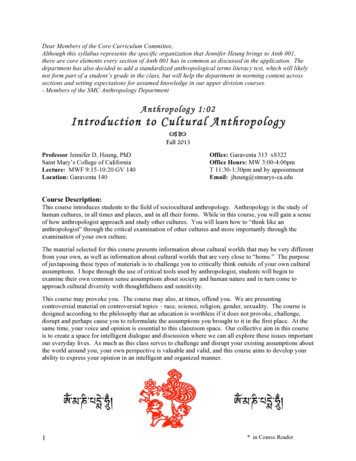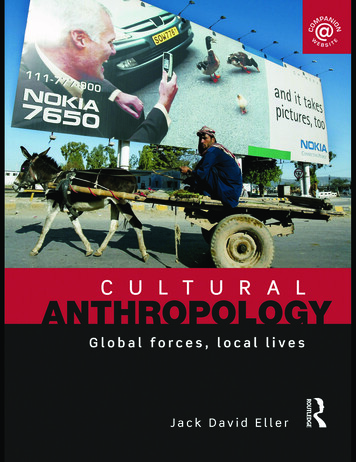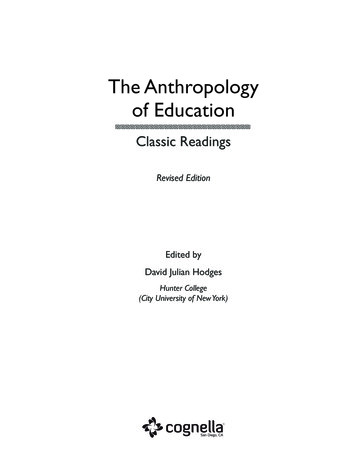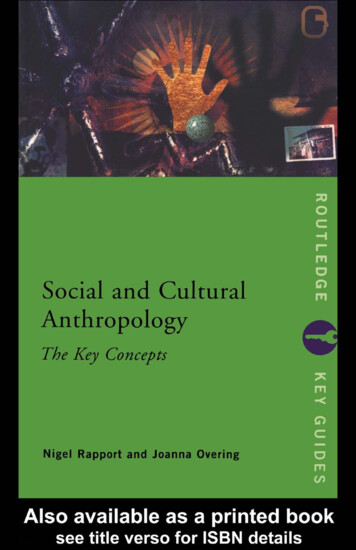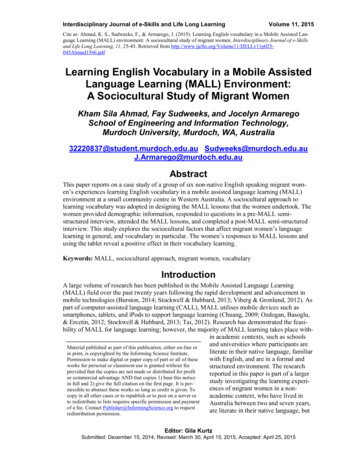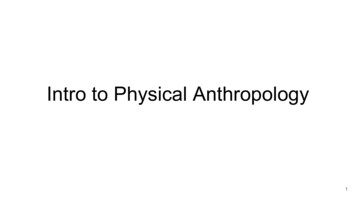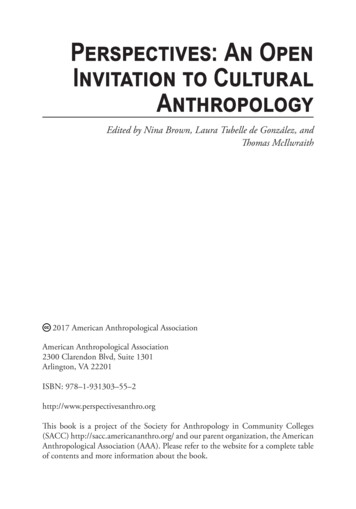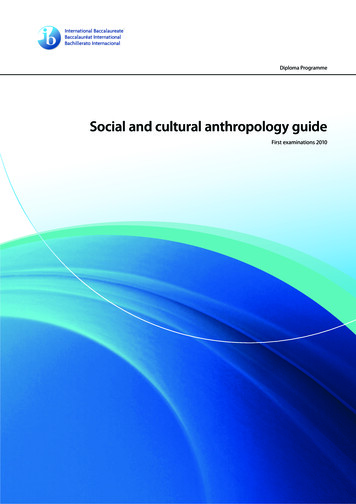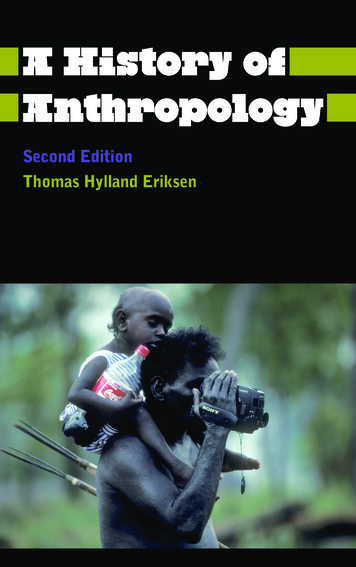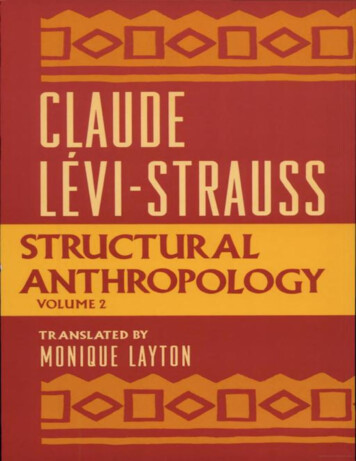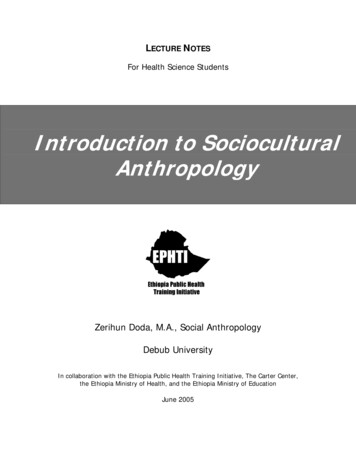
Transcription
LECTURE NOTESFor Health Science StudentsIntroduction to SocioculturalAnthropologyZerihun Doda, M.A., Social AnthropologyDebub UniversityIn collaboration with the Ethiopia Public Health Training Initiative, The Carter Center,the Ethiopia Ministry of Health, and the Ethiopia Ministry of EducationJune 2005
Funded under USAID Cooperative Agreement No. 663-A-00-00-0358-00.Produced in collaboration with the Ethiopia Public Health Training Initiative, The CarterCenter, the Ethiopia Ministry of Health, and the Ethiopia Ministry of Education.Important Guidelines for Printing and PhotocopyingLimited permission is granted free of charge to print or photocopy all pages of thispublication for educational, not-for-profit use by health care workers, students orfaculty. All copies must retain all author credits and copyright notices included in theoriginal document. Under no circumstances is it permissible to sell or distribute on acommercial basis, or to claim authorship of, copies of material reproduced from thispublication. 2005 by Zerihun DodaAll rights reserved. Except as expressly provided above, no part of this publication maybe reproduced or transmitted in any form or by any means, electronic or mechanical,including photocopying, recording, or by any information storage and retrieval system,without written permission of the author or authors.This material is intended for educational use only by practicing health care workers orstudents and faculty in a health care field.
PREFACEAnthropology is a social science, which studies mankindin its entirety. The term in its literal sense means, “studyof mankind”, as it is a combination of two Greek words,namely, anthropos and logos. Anthropology has gainedpopularity rapidly within the social/ behavioral sciencescircle. Through its various fields of specialization, itoffers us great insights into the ways of lives of humansocieties across time and space.Although the science of anthropology studies all humansocieties across time and space, it has conventionallybeen accepted to associate anthropology with the studyof the societies and problems of the traditional, nonwestern peoples.Health science students learning this discipline have agreat advantage of gaining fresh insights and practicalbenefits in their personal lives and professionalpractices.disciplinesAnthropology along with other , human/ cultural geography, history andpolitical sciences has now become essential componenti
of the health and medical sciences curricula inuniversities and other training institutions abroad.Following this example, similar institutions in Ethiopiahave also included them in their curricula.Before going any further, I want to make clear that dueto its more relevance to the conditions and contexts ofdeveloping societies such as Ethiopia; as well as due tothe fact that the new health policy of the countryfocuses on the social, cultural, behavioral, and relateddimensions of health; this teaching material is more ly labeled as Introduction to SocioculturalAnthropology.These lecture notes on introductory socioculturalanthropology are prepared for the health and medicalsciences students in institutions of higher learning inEthiopia. Their purpose is to provide the students gy in general and sociocultural anthropologyin particular. By learning the materials presented inthese lecture notes, it is believed that students will beable to understand and appreciate the basic issues,ii
principles and approaches of sociocultural sions of health and disease.Specifically, the main learning objective of introductionto sociocultural anthropology is to familiarize studentswith the basic ideas, issues, concepts and principles ofanthropology. Students will be able to describe themeaning, scopes, methods, history and uses ofanthropology, and its relations to other disciplines. Thestudents will be also able to appreciate the relevance ofsociocultural anthropology in their personal and futureprofessional practice. The last chapter on medicalanthropology will particularly help students understandthe applications of anthropology in health/ medicalsciences.The lecture notes are organized seven chapters.Chapter One deals with introductory issues such as portance of anthropology and its relations to otherdisciplines. Chapter Two deals with major perspectivesof sociocultural anthropology and research methods. InChapter Three, the concept of culture is discussed.iii
Major themes and concepts in the anthropology ofculture are introduced in this section. Chapter Fourcovers topics in kinship, family and marriage. In ChapterFive, the anthropology of religion is presented. Here, themeaning, forms, functions and medical relevance ofreligion and its beliefs and practices are discussed.Important other concepts in sociocultural anthropologysuch as cross-cultural issues of gender, ethnicity andrace, and their implications for health are raised anddiscussed in Chapter Six. The last Chapter deals withselected concepts and topics in medical anthropology.Each chapter begins with learning objectives, ends witha chapter summary and has review questions. Inside thetext, there are illustrative boxes, tables and figureswhich are meant to aid the students in utilizing the notesmore effectively. Throughout the text, key terms andconcepts are highlighted in bold and they are put ces used in preparing these lecture notes arealso cited in the text and they are put in bibliographicalsection. However, it is advisable to use the lecture notesas complementary materials. Students should refer toiv
the textbooks and other references for detailed andricher knowledge.The author wishes an enjoyable and fruitful reading forthe students.v
ACKNOWLEDGEMENTSThese lecture notes are prepared with the financialassistance made by the Carter Center. I, thus, first of allwish to thank the Caret Center. I also want to thank theCollege of Health Sciences, Debub University, for givingme the chance to participate in preparing these lecturenotes. My appreciation also goes to Ato AlemanteAmera, my colleague in the College for his constructivecomment on the material, during the intra-institutionalreview meeting. I also wish to extend my deepest thanksto inter-institutional reviewers Ato Woubshet iversity; Ato Fasika Melesse, Defense UniversityCollege and Dr Mesfin Adissie, Addis Ababa University,Medical Faculty. They have constructively contributed tothese lecture notes.Last but not least, I want to express my deep gratitudeto the national reviewers: Dr Gebre Yntiso and DrTeketel Abebe of the Department of Sociology andAnthropology, who spared their precious time to reviewvi
these lecture notes. They have made valuablescomments I say, “Thank you very much!”I finally want to assure all the reviewers who contributedto this teaching material that all of your relevant andprecious comments are well taken and incorporated intothis final version.Zerihun D. Doffana, MA, Social AnthropologyJune 2005vii
TABLE OF CONTENTSContentsPagePreface. iAcknowledgements . ivTable of Contents . viiiList of Illustrative Boxes, Figures and Tables . xivCHAPTER ONE: INTRODUCTIONLearning Objectives . 11.1. What is Anthropology? . 11.1.1. Misconceptions about Anthropology . 41.2. Brief History of Anthropology . 71.3. Subject- matter and Scope of Anthropology . 111.4. Distinguishing Features of Anthropology . 141.5. The Sub-Fields of Anthropology . 171.5.1. Physical Anthropology. 181.5.2. Sociocultural Anthropology . 211.5.3. Archaeological Anthropology . 231.5.4. Linguistic Anthropology . 251.5.5. Applied Anthropology . 281.6. Contributions of Anthropology . 301.7. The Relationship of Anthropology to OtherDisciplines. 34viii
1.7.1. Similarities between Anthropology andOther Disciplines . 341.7.2. Differences between Anthropology andOther Disciplines . 351.8. Chapter Summary . 36Review Questions . 37CHAPTER TWO: THEORIES AND RESEARCHMETHODS IN SOCIOCULTURAL ANTHROPOLOGYLearning Objectives . 382.1. Theories in Sociocultural Anthropology . 382.1.1. Evolutionism. 392.1.2. Diffusionism. 412.1.3. Historical Particualrism. 422.1.4. Functionalism . 432.1.5. Culture and Personality. 452.1.6. Neo-functionalism . 462.1.7. Marxist anthropology. 462.1.8. Cultural Ecology . 472.1.9. Cultural Materialism . 492.1.10. Structuralism . 492.1.11. Ethnoscience. 502.1.12. Symbolic Anthropology . 512.2. Research Methods in Sociocultural Anthropology . 59ix
2.2.1. The Scientific Method and Inductive vs.Deductive Approaches . 592.2.2. Identification of Research Problem . 612.2.3. Literature Review . 622.2.4. Research Design. 632.2.5. Data Collection methods/ Strategies inAnthropology . 642.2.6. Data Analysis . 732.2.7. Research Report Writing andDissemination. 742.3. Chapter Summary. 75Review Questions . 78CHAPTER THREE: THE CONCEPT OF CULTURELearning Objectives . 803.1. The Concept Culture . 803.2. Main Features of Culture . 863.3. Ethnocentrism and Cultural Relativism . 933.3.1. Ethnocentrism . 933.3.2. Cultural Relativism . 943.4. Components of Culture . 973.5. Some Important Concepts Related to Cultural . 1003.5.1. Culture Region . 1003.5.2. Culture and Its Different Levels . 100x
3.5.3. Cultural Universals . 1023.5.4. Generalized Culture . 1063.5.5. Localized Culture . 1063.5.6 Culture Shock. 1073.6. Language and Culture . 1073.7. Culture and Its Influence on People’s Behavior . 1083.8. Chapter Summary . 110Review Questions . 113CHAPTER FOUR: KINSHIP, MARRIAGE AND THE FAMILYLearning Objectives . 1154.1. What is Kinship?. 1154.2. Defining Marriage . 1174.3. Types of Marriage . 1184.4. Rules of Marriage . 1214.5. Marriage Payments . 1224.6. Definition and Types of the Family . 1234.7. The Functions of Family . 1244.8. Trends in and Problems of Contemporary Marriageand the Family . 1264.9. Chapter Summary . 127Review Questions . 129xi
CHAPTER FIVE: GENDER, ETHNICITY AND RACELearning Objectives . 1305.1. Defining the Concept of Gender . 1305.2. Gender Role Socialization . 1325.3. Gender Stereotypes and Stratification . 1335.3.1. Gender Stereotypes . 1335.3.2. Gender Stratification . 1335.4. Implications of Gender Role Socialization for Health. 1355.5. Differentiating Ethnicity and Race . 1375.6. Ethnic and Racial Stereotypes/DiscriminationsAffecting Access to Health Care . 1415.7. Chapter Summary. 145Review Questions . 147CHAPTER SIX: THE ANTHROPOLOGY OF RELIGIONLearning Objectives . 1486.1. What is the Anthropology of Religion? . 1486.2. Definition of Religion . 1506.3. Types and Functions of Religion . 1516.4. Religion and Health . 1566.5. Chapter Summary . 161Review Questions . 164xii
CHAPTER SEVEN: ANTHROPOLOGY AND HEALTHLearning Objectives . 1657.1. Medical Anthropology: Definition, History andConcerns . 1667.2. Some Theories of Health, Culture and Society . 1687.2.1. The Functionalist Perspective . 1687.2.2. The Medical Ecological Perspective . 1697.2.3. Cultural Interpretationist Perspective . 1697.2.4. The Critical Perspective . 1707.3.Roles of Anthropologists and Contributions ofAnthropology to Health . 1707.4. Disease, Society and Economic Activity . 1737.5. Theories of Disease Causation . 1757.6. Health Care Systems . 1807.6.1. Traditional Medicine . 1817.6.2. The Bio-medical Health System . 1827.6.3. Relationship between Traditional andModern Health System . 1837.7. Chapter Summary . 193Review Questions . 195Glossary. 197References . 214xiii
LIST OF ILLUSTRATIVE BOXES TABLES ANDFIGURESIllustrative boxesPageBox 1.1.Definition of anthropology . 2Box 1.2 Misconceptions about socioculturalanthropology . 7Box 1.3. Differences between ethnography andethnology . 11Box 1.4. Distinguishing features of anthropology. 17Box 1.5. Major branches and specializations inanthropology . 29Box 2.1. Inductive and deductive approaches . 61Box 2.2.Emic and etic approaches . 68Box 2.3. Major qualitative research methods . 72Box 2.4. Qualitative vs. quantitative data . 74Box 3.1. An often-cited definition of culture given by E.B. Tylor. 85Box 3.2. Ten important features of culture . 92Box 4.1. Forms of marriage . 121Box 5.1. Ethnicity, race and racism. 140Box 6.1. The four roles of religion . 156Box 6.2. Issues in religion and medicine. 161Box 7.1. Theories of disease causation . 179xiv
TablesTable 2.1. Summary of theories in socioculturalanthropology . 52Table 3.1. A list of some cultural universals. 104Table 7.1. Strengths and weaknesses of traditional andscientific medicine. 190FiguresFigure 4.1. An example of nuclear family form . 124xv
Introduction to Sociocultural AnthropologyCHAPTER ONEINTRODUCTIONLearning ObjectivesAfter completing this Chapter, the students are expectedto: Define anthropology and describe its basicconcerns and subject matter; Describe the different sub-fields of anthropology; Explain how and why sociocultural anthropologyas a science emerged; Appreciate the contributions and applications ofanthropology in personal and professional lives;and Compare and contrast anthropology with otherrelated behavioral or social sciences.1.1. What is Anthropology?The term anthropology is a combination of two wordsderived from Greek language: anthropos and logos.The term anthropos is equivalent to the word mankind orhuman being, while logos means study or science. So1
Introduction to Sociocultural Anthropologyputting the two words together, anthropology is thestudy or science of mankind or humanity. The followingare two important, simple, definitions of anthropology:Box 1.1. A simple definition of anthropologyAnthropology is the study or science of mankindor humanity Anthropology is the study of humanity. Anthropology is a broad scientific disciplinededicated to the comparative study of humans asa group, from its first appearance on earth to itspresent stage of development.In a more specific term, anthropology is science which: Investigates the strategies for living that arelearned and shared by people as members ofhuman social groups; Examines the characteristics that human beingsshare as members of one species (homosapiens) and the diverse ways that people livein different environments; and2
Introduction to Sociocultural Anthropology Analyzes the products of social groups: materialobjects (tools, cloths, houses, etc) and nonmaterial creations (beliefs, values, practices,institutions, etc). (World Book Encyclopedia.Vol.1 PP. 545-548)It should further be stressed that anthropology focuseson (1) the origin of humans, (2) the evolutionarydevelopment of humans, (3) human physical, biochemical and cultural variations, and (4) the materialpossessions and cultural heritages of humans.Anthropology seeks to explain how and why people areboth similar and different through examination of ourbiological and cultural past and comparative study ofcontemporary human societies (Howard and DunaifHattis, 1992:3). Howard and Dunaif-Hattis (1992) furthernote that:Anthropology’s ultimate goal is to develop anintegrated picture of humankind—a goal thatencompasses an almost infinite number ofquestions about all aspects of our existence. Weask, for example, what makes us human? Whydo some groups of people tend to be tall and3
Introduction to Sociocultural Anthropologylanky, while others tend to be short and stocky?Why do some groups of people practiceagriculture, while others hunt for a living?Anthropologists are interested in all thingshuman. (P.3)Anthropology has a strong affinity with natural sciencesas well. In fact, anthropology is well known by thataspect of it which is mainly concerned with thebiological/ physical dimensions of mankind as abiological being in group context. Hence, it may beinappropriate to say that anthropology is only a socialscience. It is also a natural science, not in the sense thatit deals with the natural phenomenon or man as anindividual entity per se, but in the sense that one of itsmain interests is to study man and man's behavior as aproduct of the natural processes, and in the context ofthe animal kingdom (Scupin and DeCorse, 1995).1.1.1. Misconceptions about AnthropologyThere are a number of misconceptions associated withanthropology due to lack of appropriate awareness of itsnature. The following are some of the misconceptions4
Introduction to Sociocultural nthropology instructor): One misconception about anthropology is related tothe area of its study. It is said that anthropology islimited to the study of "primitive" societies. Indeed,most of the works done by anthropologists duringearly periods focused on isolated, "primitive", smallscale societies. However, anthropologists nowadaysstudy the advanced, complex societies as well. Another misconception is that anthropologists onlystudy the rural people and rural areas. True, most ofthe works conducted focused on rural areas. Butnow, anthropologists are also interested in the studyof urban people and urban areas. There is a distinctsub-discipline devoted to the study of urbansocieties -urban anthropology-which focuses onsmall-scale society in a complex city. It is claimed that anthropologists are only interestedin the study of far away, remote exotic communitiesliving isolated from the influences of modernization.True, most anthropologists go to fieldwork to an5
Introduction to Sociocultural Anthropologyisolated people in a distant corner. But nowanthropologists are interested in home anthropology,studying anthropology at home, i.e., in one's ownsociety. It is also said that the purpose of anthropology is tostudy in order to keep and preserve ropologists are advocates of defunct, obsoleteculture. True, when anthropologists study "primitive"society, they study the culture of the people, toreconstruct it, to give meaning to the peculiarbehaviors of people. However, anthropologists donot defend "primitiveness"; they play a great role inbringing about positive change and development inthe lives of people.6
Introduction to Sociocultural logy1. Anthropology is limited to the study of"primitive" societies.2. Anthropologists only study the rural peopleand rural areas.3. Anthropologists are only interested in thestudy of far away, remote exotic ization.4. Anthropology wants to keep and s and anthropologists are advocatesof defunct, obsolete culture.1.2 Brief Historical Overview of AnthropologyThe facts of the incredibly diverse and at the same timeessentially similar nature of humans over time andspace have intrigued curious-minded people over thecentury. The history of anthropological thought is repletewith many and varied ideas, some of which often werewild extremes resulting from ethnocentric attitudes.Before anthropology attained the status of scientific7
Introduction to Sociocultural Anthropologydiscipline curious-minded persons from ancient tomedieval times have speculated a lot about the issuesand problems that concern anthropologists today(Hodgen, 1964).That is, the present academicanthropology has its roots in the works and ideas of thegreat ancient and Medieval Greek, Roman, and Hebrewphilosophers and social thinkers. These people wereinterested in the nature, origin and destiny of man, andthe morality and ethics of human relationshipsWhile the roots of (socio-cultural) anthropology can begenerally traced through the history of western cultureas far back as ancient Greek social philosophicalthinking, the discipline did not emerge as distinct field ofstudy until the mid-nineteenth century. Anthropology asan academic discipline was born during the 19th century(see The New Encyclopedia Britannica (Macropedia).Vol. 27 PP.326-331).Anthropology as academic discipline was born out of nment, which is the eighteenth century ress and the poser of reason, and based on8
Introduction to Sociocultural AnthropologyDarwinian Theory of Evolution (Scupin and DeCorse,1995).According to Howard and Dunaif-Hattis (1992:362):By the late 1870s, anthropology was beginningto emerge as a profession. A major impetus forits growth was the expansion of western colonialpowers and their consequent desire to betterunderstand the peoples living under colonialdomination. In the United States, for example,the government sought information on NativeAmerican peoples who were being subdued andplaced on reservations. As the tribes weresubdued, anthropologists were employed to helpdevise means to administer these people. [H]owever, many anthropologists were motivatedby the desire to record local customs before theydisappeared and were forgotten . Anthropologybecame a profession primarily in museums,During the 1870s and 1880s many museumsdevoted to the study of humankind were foundedin Europe, North America and South America .Anthropology’s link with museums influenced itsdevelopment throughout the late nineteenth and9
Introduction to Sociocultural Anthropologyearly twentieth centuries Professionalizationduring the latter part of nineteenth and earlytwentieth centuries made great breakthroughs inthequalityandquantityofethnographicresearch .Early anthropologists mainly studied small communitiesin technologically simple societies. Such societies areoften called by various names, such as, traditional, nonindustrialized or simple societies. Anthropologists of theearly 1900s emphasized the study of social and culturaldifferences among human groups. Here, many of theindigenous peoples of the non-western world and theirsocial and cultural features were studied in detail anddocumented. This approach is called ethnography. Bythe mid-1900, however, anthropologists attempted todiscover universal human patterns and the common biopsychological traits that bind all human beings. Thisapproach is called ethnology. Ethnology aims at thecomparative understanding and analysis of differentethnic groups across time and space (Kottak, 2002;Scupin and DeCorse, 1995).10
Introduction to Sociocultural AnthropologyBox 1.3. Difference between ethnography andethnologyEthnography: description of the culture of a certaingroup of people.Ethnology: Anthropological attempt to discoveruniversal human patterns and the common biopsychological traits that bind all human beings.1.3. Subject Matter and Scope of AnthropologyThe subject matter of anthropology is very vast. Thesubject covers all aspects of human ways of life andculture, as humans live in a social group relationship.Discovering the meaning, nature, origin, and destiny ofhumanity is one of the key concerns of anthropology.According to the present stage of scientific knowledgeattained in anthropology, the term humanity or mankindis a very difficult term to define. Anthropologists seem tobe unsure whether humanity is absolutely dichotomouswith other lower forms of animals. Some may even tendto regard humanity and non-humanity as something thatis best understood in the form of continuum. This senseof continuum may be particularly in terms of time scale.Thus, the farther we go in time backwards, the narrower11
Introduction to Sociocultural Anthropologybecomes the difference between humanity and nonhumanity.It has now become a generally accepted fact ullisaevidencesareproducttheofevolutionary processes, and that humans have evolvedfrom their closest living primates (Bryan, 1997; Behe,1996).Anthropology is interested in some of the followingquestions and issues about humans: Where did human species come from (i.e. whatare the origins of mankind)? Were human beings created in the image andlikeness of God, or were they just the products ofmillions of years of the natural, evolutionaryprocess? In what ways does man differ from other animalspecies? How did mankind arrive at the present
Important other concepts in sociocultural anthropology such as cross-cultural issues of gender, ethnicity and race, and their implications for health are raised and discussed in Chapter Six. The last Chapter deals w
